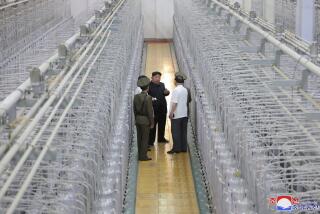U.S. Group Tells of N. Korea A-Pledge : Proliferation: But other statements point up difficulties in resolving questions about nation’s nuclear program.
BEIJING — North Korean officials, in a bid for better U.S. relations, have told a visiting American delegation that Pyongyang will allow international inspection of all suspected nuclear facilities, the U.S. group announced here Tuesday.
Other North Korean statements, however, pointed up what could be new difficulties in resolving questions about the Communist nation’s nuclear research program, the Americans said in a six-page report summarizing their findings. The United States and other Western countries have expressed concern that Pyongyang appears to be embarked on a nuclear weapons program.
“This report contains significant new information that points up the considerable problems that the IAEA (International Atomic Energy Agency) will face in establishing definitely the true nature of North Korea’s nuclear program,” said Selig S. Harrison, a senior associate at the Carnegie Endowment for International Peace, which sponsored the delegation.
“North Korean leaders appeared ready to cooperate in finding means of allaying suspicions concerning their nuclear program in the hope that a rapid resolution of the nuclear issue would pave the way for the early normalization of political and economic relations with the United States,” the Carnegie delegation said in its report. “They gave the delegation the most explicit public assurances they have yet offered that IAEA inspectors will be given access to any facilities or structures they wish to inspect, including the building identified by U.S. satellite intelligence as a reprocessing (plutonium separation) plant.”
This building, a key focus of U.S. concern, was not included on a list of acknowledged nuclear facilities recently provided to the IAEA, the report said. This facility is critical because plutonium is the key ingredient in one kind of nuclear bomb.
The Carnegie delegation report quoted Deputy Prime Minister and Foreign Minister Kim Yong Nam as stating: “The IAEA will be able to see anything it likes. If it wishes, we can show other facilities, even those not on the initial inventory (submitted to the agency).”
Kim was asked whether this includes the building identified by the United States as a reprocessing plant, the report said, and he replied: “If they wish, we’ll show it.”
The facility was also discussed in an exchange between Harrison and Choe Jong Sun, a spokesman for the Ministry for Atomic Energy Industry, the report said. It quoted Choe as stating: “We’ll open all facilities covered (by the North Korea-IAEA inspection) agreement, and if they want to see others, we’ll open them.”
The Koreans also noted that Hans Blix, the IAEA director, is scheduled to visit North Korea beginning Sunday.
“If we didn’t want to settle it, why would we invite the IAEA director and the inspectors?” Kim Yong Sun, secretary for international affairs of the Korean Workers’ Party, which is the ruling Communist party, told the delegation, according to the report.
Other statements by Choe, however, illuminated the difficulty of determining whether North Korea has already stockpiled enough plutonium to make one or more bombs.
Choe said, according to the report, that a uranium-powered five-megawatt nuclear reactor at Yongbyon, on which construction was completed in 1986, has produced only a very limited quantity of plutonium-bearing used fuel because technical problems had prevented operation of the reactor except on an intermittent basis.
“In direct contradiction to Choe’s assertions, the U.S. director of Central Intelligence, Robert M. Gates, has declared in congressional testimony that the reactor has been operating continuously for several years and has produced a significant quantity of spent fuel, containing enough plutonium for at least one nuclear device,” the report said. “Given such divergent claims, suspicions that Pyongyang is secretly stockpiling spent fuel could be exacerbated unless the IAEA is able to establish the detailed operating history of the reactor and to determine how much, if any, spent fuel has been produced.”
A related problem exists concerning reprocessing experiments at a Yongbyon laboratory, the report said.
Choe acknowledged that this laboratory had used a damaged fuel rod from the Yongbyon reactor to produce “a little bit of plutonium for experimental purposes.” The report said that when asked how much, he replied, “Next to nothing.”
The IAEA must examine these activities “to establish the amount of plutonium involved and to determine whether the laboratory and the material must be placed under future inspection,” the report said.
More to Read
Sign up for Essential California
The most important California stories and recommendations in your inbox every morning.
You may occasionally receive promotional content from the Los Angeles Times.










